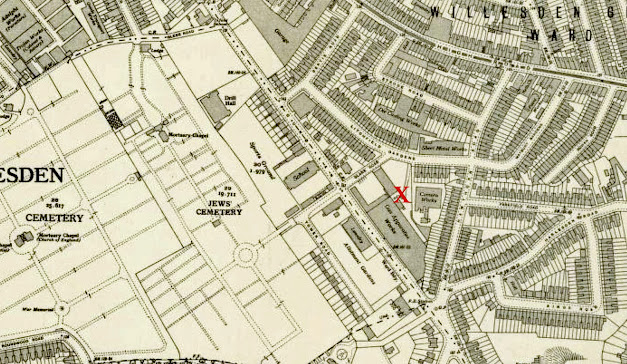Recently I was looking at the 1936 OS map of Willesden when I saw the large ‘Camera Works’ in Lichfield Gardens.
I did not know what this was until I found an aerial photo, (taken from a different direction), which said it was the Williamson Manufacturing Works. Further research showed the factory was here from 1919 and by 1961 it had moved to nearby 69 Hawthorn Road.
The company which has an interesting history, was started by James Williamson who was an early moving picture maker. He was born in 1855 in Scotland and came to London in 1868 when he was apprenticed to a chemist. He practiced as a pharmacist in Eastry, near Sandwich Kent, until 1886 when he moved to Hove. Williamson took up lantern photography as a hobby, and he was introduced to cinematography by friends including William Frise-Greene who lived in Kilburn. Williamson began to experiment with moving pictures about 1896 in his small studio, and by 1898 he had entered the film business. In his early films he frequently used his young sons as actors.
He was producing and directing his own silent films in the early 1900s. There are several on YouTube. Here is his 1901 film ‘Stop Thief’.
The Williamson Kinematograph Co. was at several Hove addresses before they opened a small office in 27 Cecil Court London in 1908. Several of his sons worked in the business which was very successful, and in 1911 the company had moved to Williamson House at 28 Denmark Street.
They opened a moving picture film processing factory in Nesbitt’s Alley High Barnet in 1913 which was there until it was sold with all the equipment in September 1934.
James Williamson died at his home 593 Upper Richmond Road East Sheen in 1933. The company continued to be run by his sons, including Alan J Williamson who had worked as a director of early Australian films from 1910 to 1913.
The Willesden works made cine cameras and other photographic equipment.
A Williamson cinematographic camera, c1918
The Eagle camera and the Williamson Pistol camera were for use in aircraft. Williamson manufactured the famous F24 aerial reconnaissance camera for the RAF from 1924 until the 1950s. It was used throughout WWII in fighters like the Spitfire and Hurricane and the Wellington and Lancaster bombers, as well as many other RAF aircraft.
In 1969 the works in Hawthorn Road Willesden, were taken over by the famous scientific optical company Negretti and Zambra which had formed in 1850. The factory was still there in 1981 when they were making control valves. Negretti and Zambra itself was taken over in 1985 by the avionics company Meggitt. Later, both the Williamson sites were demolished and replaced with modern houses.

.jpg)
.JPG)

.jpg)
Comments
Post a Comment